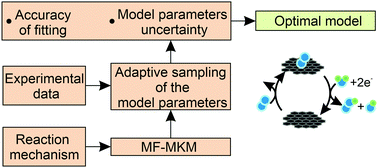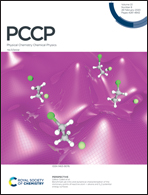Active learning-based framework for optimal reaction mechanism selection from microkinetic modeling: a case study of electrocatalytic oxygen reduction reaction on carbon nanotubes†
Abstract
The elucidation of complex electrochemical reaction mechanisms requires advanced models with many intermediate reaction steps, which are governed by a large number of parameters like reaction rate constants and charge transfer coefficients. Overcomplicated models introduce high uncertainty in the choice of the parameters and cannot be used to obtain meaningful insights on the reaction pathway. We describe a new framework of optimal reaction mechanism selection based on the mean-field microkinetic modeling approach (MF-MKM) and adaptive sampling of model parameters. The optimal model is selected to provide both the accurate fitting of experimental data within the experimental error and low uncertainty of model parameters choice. Generally, this approach can be applied for any complex heterogeneous electrochemical reaction. We use the “2e−” electrocatalytic oxygen reduction reaction (ORR) on carbon nanotubes (CNTs) as a representative example of a sufficiently complex reaction. Rotating disk electrode (RDE) experimental data for both ORR in O2-saturated 0.1 M KOH solution and hydrogen peroxide oxidation/reduction reaction (HPRR/HPOR) in Ar-purged 0.1 M KOH solution with different HO2− concentrations were used to show the dependence of the model parameters uniqueness on the completeness of the experimental dataset. It is demonstrated that the optimal reaction mechanism for ORR on CNT and available experimental data consists of O2 adsorption step on the electrode surface and effective step of two-electron reduction to HO2− combined with its desorption from the electrode. The low uncertainty of estimated model parameters is provided only within the 2-step model being applied to the full available experimental dataset. The assessment of elementary step mechanisms on electro-catalytic materials including carbon-based electrodes requires more diverse experimental data and/or higher precision of experimental measurements to facilitate more precise microkinetic modeling of more complex reaction mechanisms.



 Please wait while we load your content...
Please wait while we load your content...